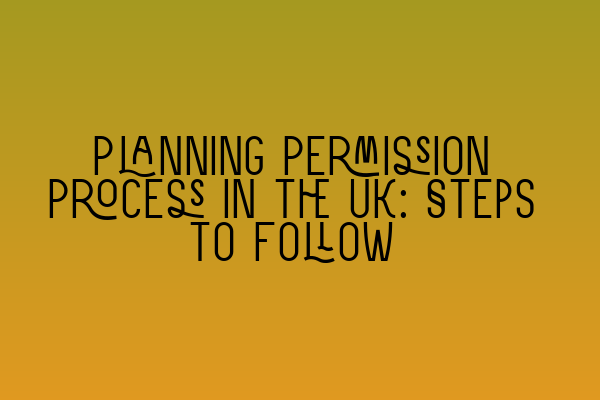Planning Permission Process in the UK: Steps to Follow
Are you planning to make alterations to your property? Or perhaps you’re thinking about constructing a new building? Whatever your plans may be, it’s crucial to understand the planning permission process in the UK. Obtaining the necessary permissions and complying with the law is essential to avoid legal issues and potential penalties.
In this article, we’ll walk you through the steps you need to follow when applying for planning permission in the UK. We’ll provide you with a clear and simplified explanation, helping you navigate the process with ease.
1. Determine if Planning Permission is Required
The first step is to determine whether your project requires planning permission. Not all changes to a property require permission, as there are certain permitted development rights. These rights grant homeowners the ability to make specific alterations without formal approval. However, it’s essential to double-check the specific regulations and limitations that apply to your property.
To help you determine if your project requires planning permission, consult with a qualified property solicitor. They will be able to assess your plans and provide you with expert guidance.
2. Research Local Planning Policies
Once you’ve established that planning permission is required, the next step is to research your local planning policies. Each local planning authority (usually your local council) has its own set of policies and guidelines that outline what is permissible and what is not within their jurisdiction.
Understanding these policies is crucial because it will help you tailor your planning application to match local requirements. Consider factors such as building heights, materials, building density, and any restrictions that may be in place due to the property’s location.
3. Prepare a Detailed Planning Application
Now that you have an understanding of the local planning policies, it’s time to prepare a detailed planning application. This is a critical step in the process, as a well-prepared application will significantly increase your chances of success.
The planning application should include detailed architectural plans, elevations, and any additional documents required by the local authority. Be prepared to provide thorough information about your project, including the purpose, size, materials, and impact on the surrounding area.
4. Submit the Application to the Local Planning Authority
Once your planning application is complete, you need to submit it to the relevant local planning authority. The submission process usually involves filling out an application form, paying the necessary fees, and providing all the required documents.
Submitting the application triggers the start of the statutory planning process, during which the local authority will review your proposal and consider any objections or concerns raised by the public or other stakeholders.
5. Public Consultation and Decision Period
After the planning application is submitted, a public consultation period begins. This allows the general public and other interested parties to provide feedback and raise any objections they may have to the proposed development.
The local authority will review all the comments received and weigh them against planning policies and other factors. They will then make a decision on whether to grant planning permission, refuse it, or request modifications to the proposal.
6. Receive a Decision Notice
Once the local authority has made a decision regarding your planning application, they will issue a decision notice. This notice will outline any conditions that must be met if planning permission is granted or the reasons for refusal if the application is denied.
If planning permission is granted, it’s essential to read the decision notice carefully and ensure that you adhere to any specified conditions before proceeding with your project.
7. Appeal a Refusal (if necessary)
In the event that your planning application is refused, you have the right to appeal the decision. Appeals are reviewed by the Planning Inspectorate, an independent organization that assesses planning decisions.
To appeal a refusal, you must provide valid reasons, evidence, and supporting documentation to substantiate your case. It’s highly recommended to seek the assistance of a specialist property solicitor experienced in handling planning appeals.
Conclusion
Navigating the planning permission process in the UK can be a complex and time-consuming task. By thoroughly understanding the steps involved and seeking expert advice when needed, you can increase your chances of a successful outcome.
If you require further assistance or want to delve deeper into the subject, SQE Property Law & Land Law can provide you with expert guidance. Whether you need help with planning applications, appeals, or any other property law matters, our professional team is here to assist you.
Related Articles:
– SQE 1 Practice Exam Questions
– SQE 1 Practice Mocks FLK1 FLK2
– SQE 2 Preparation Courses
– SQE 1 Preparation Courses
– SRA SQE Exam Dates
